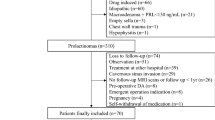Abstract
Objective Normalization of serum prolactin concentrations in patients with prolactinomas is an accepted endpoint of therapy. Clinical signs and symptoms of hyperprolactinemia are usually resolved when prolactin levels are lowered to within the normal range. While most patients are treated with dopamine agonist drugs, some patients require surgical resection of their tumors. We sought to determine whether preoperative treatment with dopamine agonists alters the outcome of surgical intervention. Methods and results We present an analysis of 253 patients with prolactinomas treated surgically during the period of time when dopamine agonist therapy was first introduced and prior to its widespread use as first-line therapy. We compared both short- and long-term outcomes of patients treated with dopamine agonists prior to surgery with those undergoing surgery as their initial treatment modality. Our data showed that that patients treated with dopamine agonists prior to surgery experienced greater reductions in prolactin levels, had lower prolactin levels, were more likely to have normal prolactin levels at long term follow-up, and were less likely to require additional therapy to control their prolactin levels. Conclusion Our study provides strong evidence suggesting that, regardless of initial prolactin level, preoperative dopamine agonist therapy is not detrimental. In fact, pretreatment with dopamine agonist drugs, possibly by inducing tumor regression, seemed to improve the surgeon’s ability to resect a greater percentage of the tumor and led to better control of the prolactin level.



Similar content being viewed by others
References
Gillam MP, Molitch ME, Lombardi G, Colao A (2006) Advances in the treatment of prolactinomas. Endocr Rev 27:485–534. doi:10.1210/er.2005-9998
Wilson CB (1997) Surgical management of pituitary tumors. J Clin Endocrinol Metab 82:2381–2385. doi:10.1210/jc.82.8.2381
Soule SG, Farhi J, Conway GS, Jacobs HS, Powell M (1996) The outcome of hypophysectomy for prolactinomas in the era of dopamine agonist therapy. Clin Endocrinol (Oxf) 44:711–716. doi:10.1046/j.1365-2265.1996.738559.x
Bevan JS, Adams CB, Burke CW, Morton KE, Molyneux AJ, Moore RA et al (1987) Factors in the outcome of transsphenoidal surgery for prolactinoma and non-functioning pituitary tumour, including pre-operative bromocriptine therapy. Clin Endocrinol (Oxf) 26:541–556. doi:10.1111/j.1365-2265.1987.tb00809.x
Landolt AM, Keller PJ, Froesch ER, Mueller J (1982) Bromocriptine: does it jeopardise the result of later surgery for prolactinomas? Lancet 2:657–658. doi:10.1016/S0140-6736(82)92756-8
Faglia G, Moriondo P, Travaglini P, Giovanelli MA (1983) Influence of previous bromocriptine therapy on surgery for microprolactinoma. Lancet 1:133–134. doi:10.1016/S0140-6736(83)91782-8
Fahlbusch R, Buchfelder M, Rjosk HK, von Werder K (1984) Influence of preoperative bromocriptine therapy on success of surgery for microprolactinoma. Lancet 2:520. doi:10.1016/S0140-6736(84)92596-0
Giovanelli M, Losa M, Mortini P, Acerno S, Giugni E (1996) Surgical results in microadenomas. Acta Neurochir Suppl (Wien) 65:11–12
Weiss MH, Wycoff RR, Yadley R, Gott P, Feldon S (1983) Bromocriptine treatment of prolactin-secreting tumors: surgical implications. Neurosurgery 12:640–642
Tyrrell JB, Lamborn KR, Hannegan LT, Applebury CB, Wilson CB (1999) Transsphenoidal microsurgical therapy of prolactinomas: initial outcomes and long-term results. Neurosurgery 44:254–261. discussion 261–253 doi:10.1097/00006123-199902000-00006
Colao A, Di Sarno A, Cappabianca P, Di Somma C, Pivonello R, Lombardi G (2003) Withdrawal of long-term cabergoline therapy for tumoral and nontumoral hyperprolactinemia. N Engl J Med 349:2023–2033. doi:10.1056/NEJMoa022657
Landolt AM, Osterwalder V (1984) Perivascular fibrosis in prolactinomas: is it increased by bromocriptine? J Clin Endocrinol Metab 58:1179–1183
Esiri MM, Bevan JS, Burke CW, Adams CB (1986) Effect of bromocriptine treatment on the fibrous tissue content of prolactin-secreting and nonfunctioning macroadenomas of the pituitary gland. J Clin Endocrinol Metab 63:383–388
Takahashi T, Kuwayama A, Katoh T, Kageyama N (1986) Histological changes and operative findings of pituitary adenomas after bromocriptine treatment. Nippon Naibunpi Gakkai Zasshi 62:1336–1351
Hankinson SE (2005) Endogenous hormones and risk of breast cancer in postmenopausal women. Breast Dis 24:3–15
Author information
Authors and Affiliations
Corresponding author
Rights and permissions
About this article
Cite this article
Sughrue, M.E., Chang, E.F., Tyrell, J.B. et al. Pre-operative dopamine agonist therapy improves post-operative tumor control following prolactinoma resection. Pituitary 12, 158–164 (2009). https://doi.org/10.1007/s11102-008-0135-1
Published:
Issue Date:
DOI: https://doi.org/10.1007/s11102-008-0135-1




